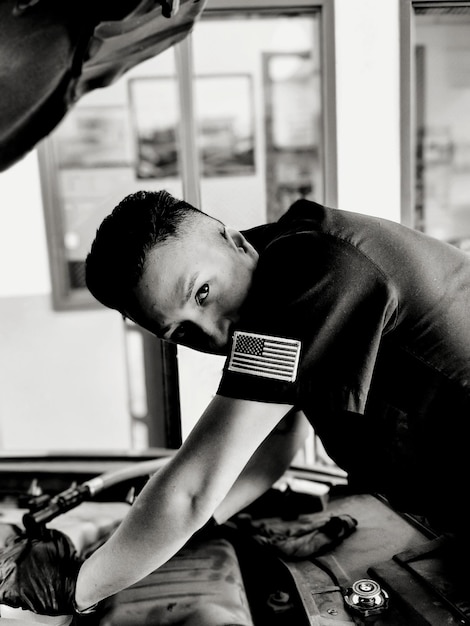Automotive Influencers: Shaping Car Culture on Social Media

The rise of automotive influencers is transforming car culture by leveraging social media platforms to engage enthusiasts, promote brands, and shape consumer preferences in the automotive industry.
The digital age has revolutionized how we consume information and connect with various communities, and the automotive world is no exception. The rise of automotive influencers: shaping car culture on social media platforms, has become a significant force, impacting everything from car sales to the very definition of car enthusiasm. These influencers, with their engaging content and dedicated followers, are redefining how cars are perceived and celebrated.
The Evolution of Car Culture in the Digital Age
Car culture has historically been shaped by traditional media like magazines, TV shows, and auto shows. However, the digital revolution and the advent of social media have democratized content creation and distribution. This shift has paved the way for automotive influencers to rise in prominence, offering a more personalized and accessible perspective on cars.
Automotive influencers leverage platforms like YouTube, Instagram, TikTok, and Facebook to share their passion for cars. They create diverse content, including car reviews,modification tutorials, behind-the-scenes glimpses, and event coverage, catering to a broad audience of car enthusiasts.
From Magazines to Instagram: A Paradigm Shift
The shift from traditional media to social media has brought about a significant change in how car culture is experienced. Traditional media often presented a polished, top-down view of cars, whereas social media offers a more intimate and relatable perspective. Automotive influencers bridge the gap between manufacturers and consumers, fostering a direct, two-way communication.
The Power of Authenticity
One of the key factors contributing to the success of automotive influencers is their authenticity. Unlike traditional advertising, which can sometimes feel detached and impersonal, influencers build trust with their audience by sharing their genuine experiences and opinions. This authenticity resonates with viewers, making them more likely to engage with the content and consider the influencer’s recommendations.
- Authenticity builds trust between influencers and their followers.
- Social media platforms allow for direct engagement and feedback.
- Diversified content creation caters to different audience segments.
In conclusion, the digital age has transformed car culture, with automotive influencers playing a pivotal role. Their ability to connect authentically with audiences, provide diverse content, and foster direct engagement has significantly impacted the automotive industry. As social media continues to evolve, the influence of these digital trendsetters is set to grow even further.

Key Platforms for Automotive Influencers
Automotive influencers utilize various social media platforms, each offering unique features and audience demographics. Understanding these platforms is crucial to appreciating the diverse strategies influencers employ to connect with car enthusiasts.
YouTube, Instagram, TikTok, and Facebook are the primary channels where automotive influencers showcase their content. Each platform caters to different content formats and audience preferences, requiring influencers to adapt their strategies accordingly.
YouTube: The Hub for In-Depth Car Reviews
YouTube is the go-to platform for detailed car reviews, modification tutorials, and project car builds. Influencers like Doug DeMuro and Mighty Car Mods have built massive followings by providing comprehensive and entertaining content that appeals to car enthusiasts seeking in-depth information.
Instagram: Visual Storytelling
Instagram is ideal for visual storytelling, allowing influencers to showcase stunning car photography, event coverage, and lifestyle content. Accounts like Larry Chen Photography and Amy Kate’s automotive photography highlight the beauty and excitement of car culture, reaching audiences with visually appealing content.
- YouTube offers in-depth car reviews and tutorials.
- Instagram focuses on visually appealing car photography and lifestyle content.
- TikTok provides short-form, engaging content, often with a comedic twist.
In summary, automotive influencers leverage various social media platforms to reach diverse audiences. YouTube is perfect for detailed content, Instagram for visual storytelling, and TikTok for short, engaging videos. These platforms enable influencers to shape car culture by providing personalized and accessible perspectives on cars.
How Automotive Influencers Impact Consumer Behavior
Automotive influencers wield significant influence over consumer behavior, impacting car sales, brand perception, and purchasing decisions. Their authentic content and direct engagement with audiences create a powerful connection that traditional advertising often struggles to achieve.
Influencers can drive car sales by showcasing the latest models, highlighting features, and providing real-world reviews. They also shape brand perception by aligning with brands that match their values and audience preferences, fostering trust and credibility.
Driving Car Sales Through Authentic Reviews
Automotive influencers provide authentic reviews that resonate with potential buyers. By sharing their genuine experiences, they give consumers insights into a car’s performance, reliability, and overall value.
Shaping Brand Perception
Influencers play a crucial role in shaping brand perception. Their endorsement can enhance a brand’s image and build trust with consumers, as followers often view influencers as reliable sources of information.

- Influencers provide authentic car reviews that drive sales.
- They shape brand perception by aligning with trusted brands.
- Their content influences purchasing decisions through product placement and endorsements.
To conclude, automotive influencers significantly impact consumer behavior by driving car sales through authentic reviews and shaping brand perception. Their endorsements and product placements influence purchasing decisions, making them valuable partners for automotive brands seeking to connect with potential customers.
The Business of Automotive Influencing
Becoming a successful automotive influencer involves more than just a passion for cars; it requires business acumen, marketing savvy, and a deep understanding of social media analytics. Influencers monetize their content through various avenues, including sponsored content, affiliate marketing, and merchandise sales.
Monetization opportunities include sponsored content, where influencers promote products or services in exchange for payment. Affiliate marketing involves earning a commission on sales generated through unique referral links. Merchandise sales allow influencers to create and sell products that resonate with their audience, further strengthening their brand.
Sponsorships and Partnerships
Sponsorships and partnerships are key revenue streams for automotive influencers. Brands seek out influencers with engaged audiences and relevant content to promote their products and services authentically.
Affiliate Marketing
Affiliate marketing enables influencers to earn a commission on sales generated through their content. By including unique referral links in their videos or posts, influencers can track sales and receive a percentage of the revenue.
- Sponsorships and partnerships with automotive brands.
- Affiliate marketing through unique referral links.
- Merchandise sales, including branded apparel and accessories.
In conclusion, automotive influencing is a multifaceted business that requires a blend of passion, marketing skills, and business acumen. Influencers monetize their content through sponsorships, affiliate marketing, and merchandise sales, creating sustainable income streams.
The Role of Automotive Influencers in Promoting Car Culture
Automotive influencers play a vital role in promoting car culture by fostering a sense of community, showcasing diverse styles and tastes, and celebrating the passion for cars. Their content fosters engagement, encouraging enthusiasts to connect, share ideas, and participate in events.
Influencers showcase diverse styles, from classic restorations to modern modifications, catering to a wide audience of car enthusiasts. They celebrate the passion for cars through event coverage, project car builds, and enthusiast spotlights, inspiring others to pursue their automotive dreams.
Fostering a Sense of Community
Automotive influencers foster a sense of community by creating platforms for enthusiasts to connect, share ideas, and participate in events. Their content encourages engagement and builds relationships among followers.
Showcasing Diverse Styles and Tastes
Influencers showcase diverse styles, from classic restorations to modern modifications and racing, catering to a wide range of tastes and preferences. This diversity enriches car culture and promotes inclusivity.
- Building communities and encouraging engagement.
- Showcasing diverse styles and tastes.
- Celebrating the passion for cars through event coverage.
In summary, automotive influencers play a crucial role in promoting car culture by fostering a sense of community, showcasing diverse styles, and celebrating the passion for cars. Their content inspires engagement, building relationships among enthusiasts.
Challenges and Criticisms Faced by Automotive Influencers
Despite their success, automotive influencers face several challenges and criticisms, including maintaining authenticity, dealing with ethical concerns, and navigating the pressures of social media trends.
Maintaining authenticity can be challenging, as influencers must balance sponsored content with their genuine opinions. Ethical concerns arise when influencers endorse products or services without disclosing their partnerships. The pressures of social media, including algorithm changes and the need for constant content creation, also pose significant challenges.
Maintaining Authenticity in a Sponsored World
Maintaining authenticity is crucial for influencers, as followers value their genuine opinions and experiences. However, balancing sponsored content with authenticity can be challenging, requiring influencers to be transparent about their partnerships.
Ethical Considerations in Endorsements
Ethical concerns arise when influencers endorse products or services without disclosing their partnerships. Transparency is key to maintaining trust with their audience.
- Maintaining authenticity while balancing sponsored content.
- Addressing ethical concerns in endorsements and partnerships.
- Navigating algorithm changes and the need for constant content creation.
In conclusion, automotive influencers face several challenges and criticisms, including staying genuine while balancing sponsored content and addressing ethical concerns in endorsements. Overcoming these challenges requires transparency, integrity, and commitment to their audience.
The Future of Automotive Influencers
The future of automotive influencers is bright, with emerging technologies and evolving trends creating new opportunities. Virtual reality (VR), augmented reality (AR), and personalized content are set to transform how influencers engage with their audience. As the automotive industry embraces electrification and autonomous driving, influencers adapt their content to cover these new trends, demonstrating their commitment to staying relevant.
VR and AR technologies offer immersive experiences, allowing consumers to virtually test drive cars and explore features in detail. Personalized content tailors automotive content to individual preferences, enhancing engagement and driving conversions. With the rise of electric vehicles (EVs) and self-driving technology, influencers play a key role in educating consumers and shaping perceptions.
Emerging Technologies and New Opportunities
Emerging technologies like VR and AR technologies present new opportunities for automotive influencers to create immersive experiences. Virtual test drives and interactive showcases enhance engagement.
Adapting to Changing Trends
As the automotive industry evolves, influencers are adapting their content to cover emerging trends like electric vehicles and autonomous driving. They educate consumers and shape perceptions through informational content.
- Embracing emerging technologies like VR and AR.
- Adapting to changing trends like electrification.
- Creating personalized content.
In summary, automotive influencers are poised to embrace emerging technologies and adapt to changing trends. Their ability to engage with audiences, create personalized content and cover innovations shapes how car culture evolves in the digital age. The future holds opportunities to use VR, AR and electrification strategies.
| Key Point | Brief Description |
|---|---|
| 🚗 Influence | Automotive influencers impact car sales via authentic reviews. |
| 📣 Platforms | YouTube, Instagram and TikTok help to showcase content. |
| 🤝 Business | Monetization includes sponsorships and affiliate marketing. |
| 🌐 Future | The future includes VR, AR, electrification, and personalized content. |
Frequently Asked Questions
▼
An automotive influencer is a social media personality who shares content related to cars, modifications, reviews, and car culture. They use platforms like YouTube, Instagram, and TikTok to reach their audience.
▼
Automotive influencers provide authentic reviews, showcase the latest models, and highlight key features, influencing potential buyers and driving car sales through their endorsements.
▼
The main platforms are YouTube for detailed reviews, Instagram for visual content, and TikTok for short, engaging videos. Each platform helps them connect with distinct audience segments.
▼
They monetize their content through sponsorships, affiliate marketing, and merchandise sales. Partnerships with brands are very usual for influencers, and these ensure income.
▼
Challenges include maintaining authenticity, dealing with ethical concerns, and navigating algorithm changes. They need to establish the balance between sponsorships and honest opinions.
Conclusion
In conclusion, the impact of automotive influencers on car culture is undeniable. These digital trendsetters have transformed how cars are perceived, marketed, and celebrated. They leverage social media to connect with car enthusiasts, promote brands, and shape consumer behavior. As technology evolves and trends shift, automotive influencers will undoubtedly continue to play a vital role in the automotive industry.





